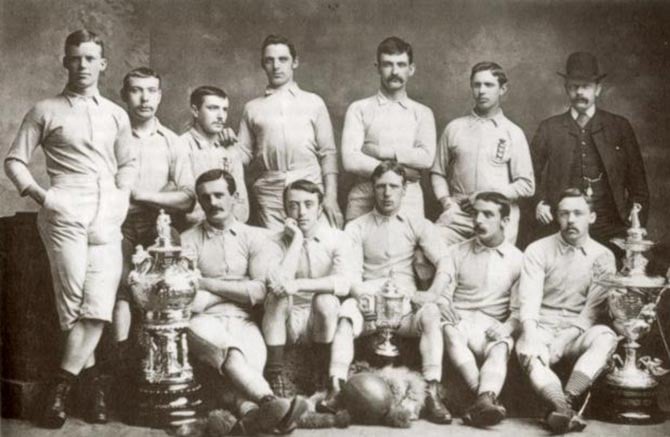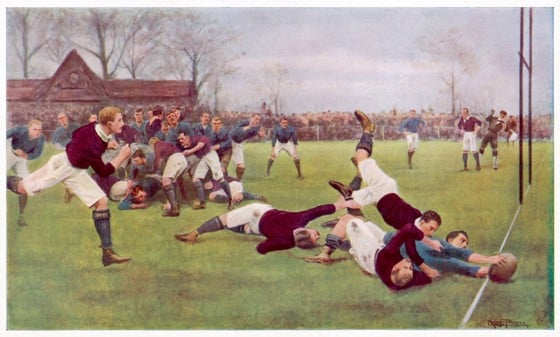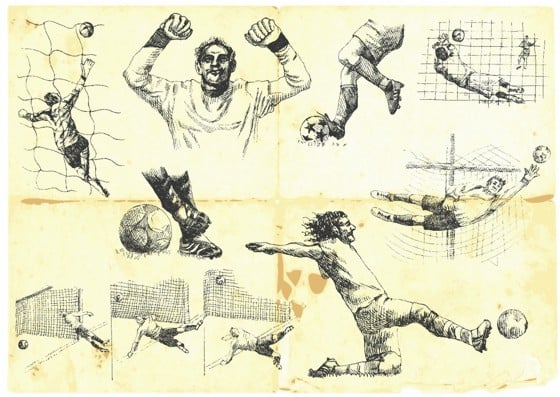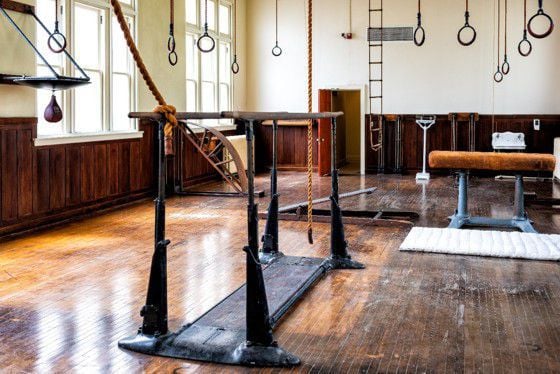The history of soccer at a glance
It all began with a ball

Soccer makes athletes’ hearts beat faster all around the world. The origins of this fascination go back thousands of years. Explore the history of soccer and learn more about your favorite sport!
Contents:
Timeline of soccer history
- 1000 BC: Mesoamerican ball games
- 3rd century BC: First forms of soccer in China "Tsu' Chu"
- 7th century AD: The Japanese ball game "Kemari"
- 12th century: Mob-, Folk- and Shrovetide Soccer - the origin of modern soccer
- 1848: Cambridge Rules
- 1858: The first English soccer club
- 1863: Founding of the first national soccer association
- 1871: Introduction of the FA Cup
- 1860: Founding of the Lausanne Soccer and Cricket Club
- 1874: Grammar school teacher Robert Koch introduces soccer as a school sport
- 1888: Founding of the oldest still existing soccer club in Germany
- 1890s: Founding of numerous soccer clubs in Germany
- 1900: Founding of the German Soccer Association (DFB)
- 1904: Foundation of the Fédération Internationale de Soccer Association (FIFA)
- 1930: FIFA organizes the first Soccer World Cup in Uruguay
- 1954: European Soccer Association UEFA is founded in Basel
- 1991: First World Cup in women's soccer takes place in China
The fascination of the ball: Soccer history in different cultures
For 2000 to 3000 years, there have been games in different parts of the world in which a ball is kicked with the foot. Completely independently, balls and rules, purposes and target groups developed in Asia, America, and Europe. From the mid-19th century onwards, within 150 years, the game with the ball advanced to the global sport we now call modern soccer. Discover how and where soccer began.
1000 BC: Mesoamerican ball games
Central America is considered the cradle of all ball games. Ancient stone playing fields point to competitions similar to Roman gladiatorial contests. Thus, the ball games were on the one hand everyday sports and on the other hand entertainment for the ruler and his court.
On a playing field, two teams competed against each other and tried to move a rubber ball, which weighed several kilos, through a stone ring. Players were not allowed to use either hands or feet. In some regions, the ball was hit with the torso, buttocks, or elbows. In other areas, clubs and bats were used. Those who could afford it wore armor. Nevertheless, it is not surprising that players were often seriously or even fatally injured.
Among the Aztecs, ullamalisztli, as their ball game was called, was also used to settle diplomatic disputes. The Maya game, pok-ta-pok, even had a religious significance: as a tribute to the gods, the entire losing team was sacrificed after the match.
Today, pok-ta-pok is coming back into fashion, but without violence. Here, the cultural heritage is the main focus. The players demonstrate great skill and physical effort:
3rd century BC: First forms of soccer in China “Tsu' Chu”
The first forms of soccer can be found in the Far East of China. Tsu’ Chu is the first ever documented soccer-like game with established rules. The ball game Tsu’ Chu originated in the 3rd century BC and is based on the discovery of a military manual from that time. The game was practiced in China as part of military training and was played in a correspondingly military and combat-oriented manner.
A ball sewn together from pieces of leather, stuffed with feathers and animal hair, was kicked into a 30–40 cm wide net placed 5 meters high. The sport, originally intended for military physical training, gradually developed into a popular form of entertainment with numerous spectators. Over the centuries, increasingly strict rules emerged: by 600 AD, an air-filled ball and soccer rules (goals, goalkeepers, captains) had been introduced. From the 9th century onwards, however, the game fell into oblivion.
7th century AD: The Japanese ball game “Kemari”
In Japan, too, a soccer-like ball game was known: Kemari. The goal was to keep the ball in the air for as long as possible through skill and body control. The players stood in a circle and wore flowing, elegant silk garments. Unlike the combat-oriented ball control in the Chinese Tsu’ Chu, Kemari had a ritual and religious component. Kemari was mainly practiced by the Chinese nobility and the samurai. Today, it is still performed on festive days in January and July.
12th century: Mob, Folk, and Shrovetide Soccer – the origin of modern soccer
Mob, Folk, or Shrovetide Soccer was played in many places in England as a combat-like mass soccer game between rival villages or city districts. Not infrequently, these games led to mass brawls. As a result, the English authorities made numerous attempts to ban soccer.
Specifically, Shrovetide Soccer is tied to the town of Ashbourne in England. Just as in the Middle Ages, the Shrovetide Soccer Match is still held every year on Shrove Tuesday and Ash Wednesday. The game is played between the districts “Up'ards” and “Down'ards,” which are located to the right and left of the River Henmore. Shrovetide Soccer is scarcely organized, combative, and spontaneous.
There is an unlimited number of players, and the goals are five kilometers apart. The river is also part of the playing field. The ball is unsuitable for kicking with the foot, as it is a four-kilo sphere filled with cork. Therefore, Shrovetide Soccer also stands in the tradition of rugby, where the ball is mainly carried and thrown. Shrovetide Soccer is thus relevant for the development of modern rugby as well as of modern soccer.
Even today, there is a place in Great Britain where a Shrovetide Soccer Match takes place every year: Ashbourne in Derbyshire. Hard to believe that from these mass brawls emerged the most popular sport in the world.
The emergence of modern soccer
In the mid-19th century, the positive qualities of team sports were recognized in England. As a result, compulsory physical education was introduced in English schools to improve students’ fitness. However, it still took decades to develop the game with the leather ball into a national sport with uniform rules.
1848: Cambridge Rules
At schools, a mixture of soccer and rugby was played, with different rules from school to school. Tournaments between the individual schools were therefore difficult to organize.
In 1848, students at the University of Cambridge wrote the first soccer rules. It was an attempt to standardize the rules of soccer and to level out the significant differences between the various teams. The biggest difference between the schools was that some emphasized playing with the hand while others emphasized playing with the foot. The Cambridge Rules gave priority to playing with the foot. This made it possible to hold official tournaments between schools.

1858: The first English soccer club
The Sheffield Soccer Club was founded in 1858 by two students from Harrow University. Today, the club is recognized as the first official soccer club in the world.
1863: Founding of the first national soccer association
Five years after the founding of the world’s first soccer club, representatives of eleven soccer clubs met at London’s Freemasons Tavern to establish universally valid rules for soccer. A total of 14 rules were set, including the prohibition of carrying or holding the ball. This marked soccer’s final separation from competing rugby. To provide the sport with a solid organizational framework, the world’s first national soccer association – the Soccer Association (FA) – was founded.

1871: Introduction of the FA Cup
The world’s first soccer competition was created with the introduction of the FA Cup in 1871. A year later, England and Scotland met in Glasgow for the first international match. The game ended 0–0. In the same year, the corner kick was also introduced and a standardized ball size was established.
Soccer history in Germany
It didn’t take long for the soccer hype to reach the other side of the English Channel. Discover how soccer gradually made its way through Europe and took root in Germany.
1860: Founding of the Lausanne Soccer and Cricket Club
Switzerland is considered a pioneer of soccer in continental Europe. The ball sport was brought into the country by English students at Swiss private schools. The first European soccer club was the Lausanne Soccer and Cricket Club (1860). It was also a Swiss, the soccer pioneer Hans Gamper, who later founded FC Barcelona.
After Switzerland, Denmark and the Netherlands were among the first European countries with national soccer clubs. Both countries founded their own soccer associations in 1889.
1874: Grammar school teacher Konrad Koch introduces soccer as a school sport
In Germany, grammar school teacher Konrad Koch made the first attempts to establish soccer in schools. He wanted to encourage his students to exercise outdoors while also teaching them the ethical virtues of team sports. In 1875, Koch published his own soccer rules.

1888: Founding of the oldest still existing soccer club in Germany
Germany’s oldest soccer club was founded in 1888 by a group of students in Berlin and was called BFC Germania. At that time, soccer was not yet a very popular or widespread sport. This was largely due to the dominance of gymnastics as the recognized national sport.
1890s: Founding of numerous soccer clubs in Germany
The delayed establishment of soccer in Germany can be traced back to the resistance of the gymnastics clubs. Gymnastics occupied the position of the German national sport. To defend this position, soccer was defamed as “un-German” or an “English disease.”
Gymnastics was primarily intended to serve military physical training and to strengthen national identity. With the establishment of soccer, a new body culture emerged in Germany that opposed the military drill of gymnastics and its political connotations. Soccer became a form of leisure activity in the bourgeois environment.
The first soccer clubs emerged from student associations or were founded by Englishmen (for example, The English Soccer Club Berlin). At the beginning, soccer was mainly played by Englishmen, students, and the wealthier segments of society. Workers did not have the necessary money for the equipment and were primarily involved in gymnastics clubs.

1900: Founding of the German Soccer Association (DFB)
The German Soccer Association (DFB) was founded in Leipzig in 1900. It provides an umbrella organization for German soccer clubs.
The international spread of soccer
Soon, it was not only cities competing against each other; national teams began to form and face one another in international matches. Here we list the greatest milestones in global soccer history.
1904: Founding of the Fédération Internationale de Soccer Association (FIFA)
The governing body for international soccer was established in 1904 with the Fédération Internationale de Soccer Association (FIFA). FIFA took over the organization of international matches and the drafting of international soccer rules. Germany joined FIFA in 1905.

1930: FIFA hosts the first Soccer World Cup in Uruguay
The first Soccer World Cup was organized by FIFA in Uruguay in 1930. Thirteen teams took part. Germany had to forgo participation for financial reasons.
1945: FIFA excludes Germany
After the end of the Second World War, FIFA excluded Germany from all matches and prohibited any sporting contact with German teams. Five years after the war, Germany was allowed to rejoin.
At the 1950 World Cup, however, Germany did not yet participate. The historic final, in which Brazil unexpectedly lost on home soil to Uruguay, is known as the Maracanaço, the Shock of Maracanã.
1954: European Soccer Association UEFA is founded in Basel
In 1954, the European Soccer Association (UEFA) was founded in Basel. In the 1955/56 season, UEFA organized for the first time the European Cup, in which European soccer clubs competed annually against each other. Since 1992, we have known this club competition under the name UEFA Champions League.
In 1960, the first UEFA European Soccer Championship took place. Since then, the national soccer teams of European countries have competed against each other every four years. From 1960 to 1964, the tournament was called the European Nations’ Cup.
1991: First Women’s Soccer World Cup takes place in China
The first official Women’s Soccer World Cup took place in China in 1991. It was organized by FIFA as the Women’s World Cup. Since then, it has been held every four years. Before that, some of the women’s national soccer teams had already met in mostly unofficial tournaments.

Soccer today: How you can write soccer history
Soccer is one of the most popular and widespread sports worldwide. According to the German Football Association, more than 7.7 million people were organized in around 24,000 soccer clubs during the 2023/2024 season. The simple and uniform rules of soccer and the minimal equipment required contribute to the game’s popularity. Internationally consistent rules make the game inclusive and cross-cultural.
Whether young or old, woman or man, on street pitches or in arenas – soccer is a global sport, celebrated, cheered, and loved by people all over the world.
At the same time, every soccer club has its own history and tradition. Do you play soccer yourself? Given the long and passionate history of the sport, you can be proud to continue this tradition. The pride in your club’s history should be reflected in the players’ jerseys. At owayo, you can design your jerseys yourself in your club’s traditional colors – and benefit from our club discount.
Thanks to our breathable ultra.dry technology, the soccer jerseys feel pleasantly cool on the skin. See for yourself. Discover our soccer apparel!
Questions and answers about the history of soccer
Briefly summarized: Here you will find answers to the most important questions about soccer history.
Where and when was soccer invented?
Soccer, as we know it today, was invented in England in the 19th century. The game shares the same origin as rugby: colleges and universities. To make interregional matches possible, students in Cambridge wrote the first soccer rules. However, it was only with the founding of the first soccer association in the 1860s that rugby and soccer became two different games.
Who is the inventor of soccer?
Modern soccer gradually developed over several decades. Therefore, there is not one single inventor of soccer. However, a key figure of the founding phase was Ebenezer Cobb Morley. He not only established the London club Barnes but also played a decisive role in founding the first soccer association. When drafting the rules, he argued that hacking – kicking the opponent on the shin – should be forbidden, thereby laying an important foundation for fairness in soccer.
Who is considered the father of German soccer history?
Konrad Koch is considered the soccer pioneer in Germany. The grammar school teacher of German, Latin, and Greek obtained a soccer from England and organized the first soccer match in Germany with his students. His goal was to keep the students away from pub crawls and to motivate them to be more physically active.
Image credits: Title image: 9elisa9 / stock.adobe.com; Image 2: Archivist / stock.adobe.com; Image 3: Lario Tus / stock.adobe.com; Image 4: kuco / stock.adobe.com; Image 5: Andriy Blokhin / stock.adobe.com; Image 6: Archivist / stock.adobe.com; Image 7: owayo

